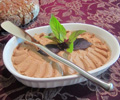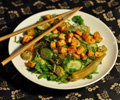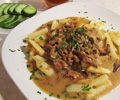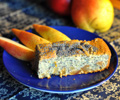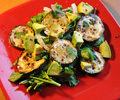In
Czech Republic Judas Buns are served for
Easter and, following the most popular legend, symbolize the
rope on which
Judas hang himself after he betrayed
Christ (the traitor had some remnants of conscience in him after all).
I have been thinking about baking these buns for a few years now. I used to make them long time ago when I incidentally acquired a Czech Cookbook in the biggest bookstore of the city of Novosibirsk, Siberia. The book was an odd item in the store, but a great find for me. There were two benefits: it had a lot of Czech recipes (as a recent traveler to then
Czechoslovakia I was interested in
Czech cuisine) and it was written in English (that was kinda hobby of mine at that time). I left the book behind when we parted with gloomy Russia and moved to the US. Luckily, on the last visit to our motherland I found this book among others and lovingly brought it back. The book is beautifully published, but recipes lack detailed instructions and rely on a person's experience. But that's OK with me.:) Actually it makes the process unpredictable and more exciting.
I took the recipe from this book and tweaked it a little. There is only 1 (!) tea spoon of sugar in the dough, the rest of sweetness comes from honey. Despite late evening, Alex ate three buns in a row, rolling his eyes with pleasure. I was also seduced to eat one... OK - two smaller ones. :) The buns are moderately sweet, have delicate slightly chewy texture (in a good way) and a rich taste of a fancy pastry, with a tiny lemony note. They can certainly be baked anytime and make a beautiful breakfast or a festive treat.
What you need:
2.75 cups flour, sifted + flour to work with dough
2.5 cups milk
3 egg yolks
100 g (7 Tbsp) butter, melted + butter for brushing
100 g (1/3 cup) honey + honey for brushing
1 tsp sugar
3 tsp instant dry yeast
1/8 tsp of salt
2-3 tsp lemon juice
1 lemon zest
Total time about 3 hours
Yields about 20 buns depending on form and size
Method:
1. Warm up milk to lukewarm in an enameled or stainless steel pot.
2. Mix yeast in 1/2 cup of this milk along with 1 tsp sugar and 1 Tbsp flour, set aside to foam.
3. Warm up together butter and honey until butter is melted.
4. Cream together egg yolks, butter and honey - stir for 5 minutes, add lemon zest.
5. Add eggs with butter and honey, salt and yeast (when foamy) to milk, stir well.
6. Warm up the mixture if necessary on very low heat. Add flour to milk mixture, stir with a wooden spoon, then transfer to the working surface and continue to knead with your hands until you have soft dough that doesn't stick to your hands.
7. Transfer dough to the pot, cover, and put in a warm place to rise. It will take about 1 hour depending on the quality of the yeast and the temperature in the room.
8. After the first rise, punch the dough down, and let rise some for the second time for about 20 minutes.
9. Cut the dough into pieces, about 1 oz each. Roll them out into 1/2" thick strings. Then improvise to your liking: twist them in half or in pairs in a rope-like manner, braid them, etc. Make them look like... ropes.
10. Place buns on a buttered baking sheet, leaving enough space between them to expand. Loosely cover with plastic wrap, put in a warm place to rise for the third time, about 30 minutes.
Again, the rising time depends on your yeast and the temperature in the room, it should be no less than 75 F. If it is rather cool in your kitchen, use the slightly warmed oven to rise your dough. Remember that temperature higher than 130 F will harm the yeast.
11. Before baking, gently brush the buns with warm melted butter.
12. Bake at 395 F for 15 minutes until golden.
While baking:
-do not open the oven first 10 minutes until the dough is set;
-do not jump;
-do not slam doors;
-do not yell.
All of the above has a disastrous impact on the texture and overall quality of baked dough: it may sink before it is baked and shaped by the heat of the oven.
13. Stir 1 Tbsp honey with lemon juice so that it becomes liquidy and brush ready buns while they are still hot.
 |
| Ready! |
Serve warm or cooled, with milk, tea, and additional honey.
Notes:
It is important to give the yeast dough time to rise well, otherwise what you will get is a tough bun or roll or whatever you bake, with dense texture and a taste of yeast - versus an airy and light texture of a well-risen dough. As aunt Shura taught me, the yeast dough usually requires three risings to be "ripe" and ready to bake. I follow this advice most of the time with good results.
These buns do stale fast. To revive them, just wrap in a paper towel and microwave for 15 seconds before eating - they will be almost as good as freshly baked.
Enjoy your Judas Buns on Easter or any day you feel a call for baking. Happy Easter 2012!

























